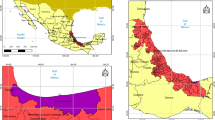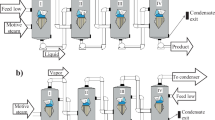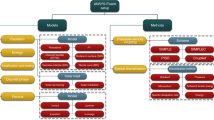Abstract
Indirect evaporative cooling (IEC) is a kind of high efficiency, energy-saving and environmental protection cooling technology, which has been widely used in data centers and other fields in recent years. In this paper, the optimized two-dimensional non-condensation state model of indirect evaporative cooling was proposed. Meanwhile the computer program was updated to solve the developed mathematical model under variable fresh air conditions. The optimized model was verified by the experimental data, and the maximum deviation was only 4.6%. Based on the modified model and the annual hourly meteorological parameters in Tianjin, China, it was analyzed the optimal heat transfer area of IEC used as fresh air pre-cooling unit under various air volumes to provide references for system design and equipment selection. Finally, taking an IEC-primary return air conditioning system of a gymnasium as an example, the hourly energy-saving effect of whole year was simulated by the developed IEC model. The simulation results showed that IEC could control the fresh air temperature below 27 °C and the moisture content below 18 g/kg throughout the year, and undertook 102.6% of the total fresh air cooling load. The findings are useful in future system optimization and design of IEC equipment.
Similar content being viewed by others
References
Al Horr Y, Tashtoush B, Chilengwe N, et al. (2020). Operational mode optimization of indirect evaporative cooling in hot climates. Case Studies in Thermal Engineering, 18: 100574.
Anisimov S, Pandelidis D, Danielewicz J (2015). Numerical study and optimization of the combined indirect evaporative air cooler for air-conditioning systems. Energy, 80: 452–464.
Berardi U, Heidarinejad G, Rayegan S, et al. (2020). Enhancing the cooling potential of a solar-assisted desiccant cooling system by ground source free cooling. Building Simulation, 13: 1125–1144.
Boukhanouf R, Amer O, Ibrahim H, et al. (2018). Design and performance analysis of a regenerative evaporative cooler for cooling of buildings in arid climates. Building and Environment, 142: 1–10.
Chen Y, Luo Y, Yang H (2015). A simplified analytical model for indirect evaporative cooling considering condensation from fresh air: Development and application. Energy and Buildings, 108: 387–400.
Chen Y, Yan H, Luo Y, et al. (2019). A proportional-integral (PI) law based variable speed technology for temperature control in indirect evaporative cooling system. Applied Energy, 251: 113390.
Chiesa G (2019). Calculating the geo-climatic potential of different low-energy cooling techniques. Building Simulation, 12: 157–168.
Cui X, Yang X, Qin S, et al. (2019). Performance investigation of an evaporative pre-cooled air-conditioning system in tropics. Energy Procedia, 158: 5673–5678.
de Antonellis S, Cignatta L, Facchini C, et al. (2020). Effect of heat exchanger plates geometry on performance of an indirect evaporative cooling system. Applied Thermal Engineering, 173: 115200.
Delfani S, Esmaeelian J, Pasdarshahri H, et al. (2010). Energy saving potential of an indirect evaporative cooler as a pre-cooling unit for mechanical cooling systems in Iran. Energy and Buildings, 42: 2169–2176.
Dong X (2016). Calculation and Test of evaporative air conditioning units’ water consumption. Master Thesis, Xi’an Polytechnic University.
Duan Z, Zhan C, Zhao X, et al. (2016). Experimental study of a counter-flow regenerative evaporative cooler. Building and Environment, 104: 47–58.
Fakhrabadi F, Kowsary F (2016). Optimal design of a regenerative heat and mass exchanger for indirect evaporative cooling. Applied Thermal Engineering, 102: 1384–1394.
GB50736-2012 (2012). Standards for Design of Heating Ventilation and Air Conditioning of Civil Buildings. Beijing, China: Architecture & Building Press. (in Chinese)
Guo C, Liu Q, Zheng B, et al. (2020). Development of model based on condensation area ratio and effect on heat transfer capacity of indirect evaporative cooling. Applied Thermal Engineering, 164: 114557.
Hao J, Chen Q, Li X, et al. (2019). A new modeling and analysis method of the indirect evaporative heat exchanger based on the heat current perspective. Applied Thermal Engineering, 163: 114331.
Huang X (2010). Theory and Application of Evaporative Cooling Air Conditioning. Beijing, China: China Architecture & Building Press. (in Chinese)
Jaber S, Ajib S (2011). Evaporative cooling as an efficient system in Mediterranean region. Applied Thermal Engineering, 31: 2590–2596.
Jain V, Mullick SC, Kandpal TC (2013). A financial feasibility evaluation of using evaporative cooling with air-conditioning (in hybrid mode) in commercial buildings in India. Energy for Sustainable Development, 17: 47–53.
Kowalski P, Kwiecień D (2020). Evaluation of simple evaporative cooling systems in an industrial building in Poland. Journal of Building Engineering, 32: 101555.
Li H, Lv J, Li Y, et al. (2019a). The effect of primary air volume flow on condensation area and performance of indirect evaporative cooler. Fluid Machinery, 47(10): 75–81. (in Chinese)
Li H, Lv J, Li Y, et al. (2019b). Experimental study on the effect of secondary-to-primary air ratio on the performance of indirect evaporative cooler. Fluid Machinery, 47(07): 56–60. (in Chinese)
Lian Z (2011). Principle and Equipment of Heat and Mass Exchange. Beijing: China Architecture & Building Press. (in Chinese)
Min Y, Chen Y, Yang H (2019a). A statistical modeling approach on the performance prediction of indirect evaporative cooling energy recovery systems. Applied Energy, 255: 113832.
Min Y, Chen Y, Yang H (2019b). Simplified predicting models on energy-saving potential of indirect evaporative coolers in Hong Kong. Energy Procedia, 159: 225–230.
Pandelidis D, Cichoń A, Pacak A, et al. (2019). Performance comparison between counter- and cross-flow indirect evaporative coolers for heat recovery in air conditioning systems in the presence of condensation in the product air channels. International Journal of Heat and Mass Transfer, 130: 757–777.
Rampazzo M, Lionello M, Beghi A, et al. (2019). A static moving boundary modelling approach for simulation of indirect evaporative free cooling systems. Applied Energy, 250: 1719–1728.
Raza HMU, Sultan M, Bahrami M, et al. (2021). Experimental investigation of evaporative cooling systems for agricultural storage and livestock air-conditioning in Pakistan. Building Simulation, 14: 617–631.
Saraei A, Moujaes SF (2021). The effects of exhaust air vent location on thermal comfort inside a residential building equipped with an evaporative cooling system. Building Simulation, 14: 1063–1075.
Tang R, Wang S, Sun S (2021). Impacts of technology-guided occupant behavior on air-conditioning system control and building energy use. Building Simulation, 14: 209–217.
You Y, Wang G, Guo C, et al. (2020). Study on mass transfer time relaxation parameter of indirect evaporative cooler considering primary air condensation. Applied Thermal Engineering, 181: 115958.
Zalewski W, Gryglaszewski PA (1997). Mathematical model of heat and mass transfer processes in evaporative fluid coolers. Chemical Engineering and Processing: Process Intensification, 36: 271–280.
Zhang X (2014). Heat Transfer. Beijing, China: Architecture & Building Press. (in Chinese)
Zheng B, Guo C, Lv J, et al. (2018). Research on influence of condensation in fresh air channels on heat transfer performance of indirect evaporative cooler. Fluid Machinery, 46(10): 55–62. (in Chinese)
Zhou X, Chen P (2000). Design and calculation method of indirect evaporative cooler. Journal of HV&AC, 30(1): 39–42. (in Chinese)
Zhuang L, Chen X, Guan X (2020). A decentralized method for energy conservation of an HVAC system. Building Simulation, 13: 155–170.
Acknowledgements
This work was supported by School of Energy and Safety Engineering, Tianjin Chengjian University. This research is financially supported by the National Natural Science Foundation of China (No. 51678385).
Author information
Authors and Affiliations
Corresponding author
Rights and permissions
About this article
Cite this article
Liu, Q., Guo, C., Wu, Z. et al. Heat and mass transfer model optimization and annual energy efficiency analysis for energy recovery indirect evaporative cooling. Build. Simul. 15, 1353–1365 (2022). https://doi.org/10.1007/s12273-021-0868-6
Received:
Revised:
Accepted:
Published:
Issue Date:
DOI: https://doi.org/10.1007/s12273-021-0868-6




